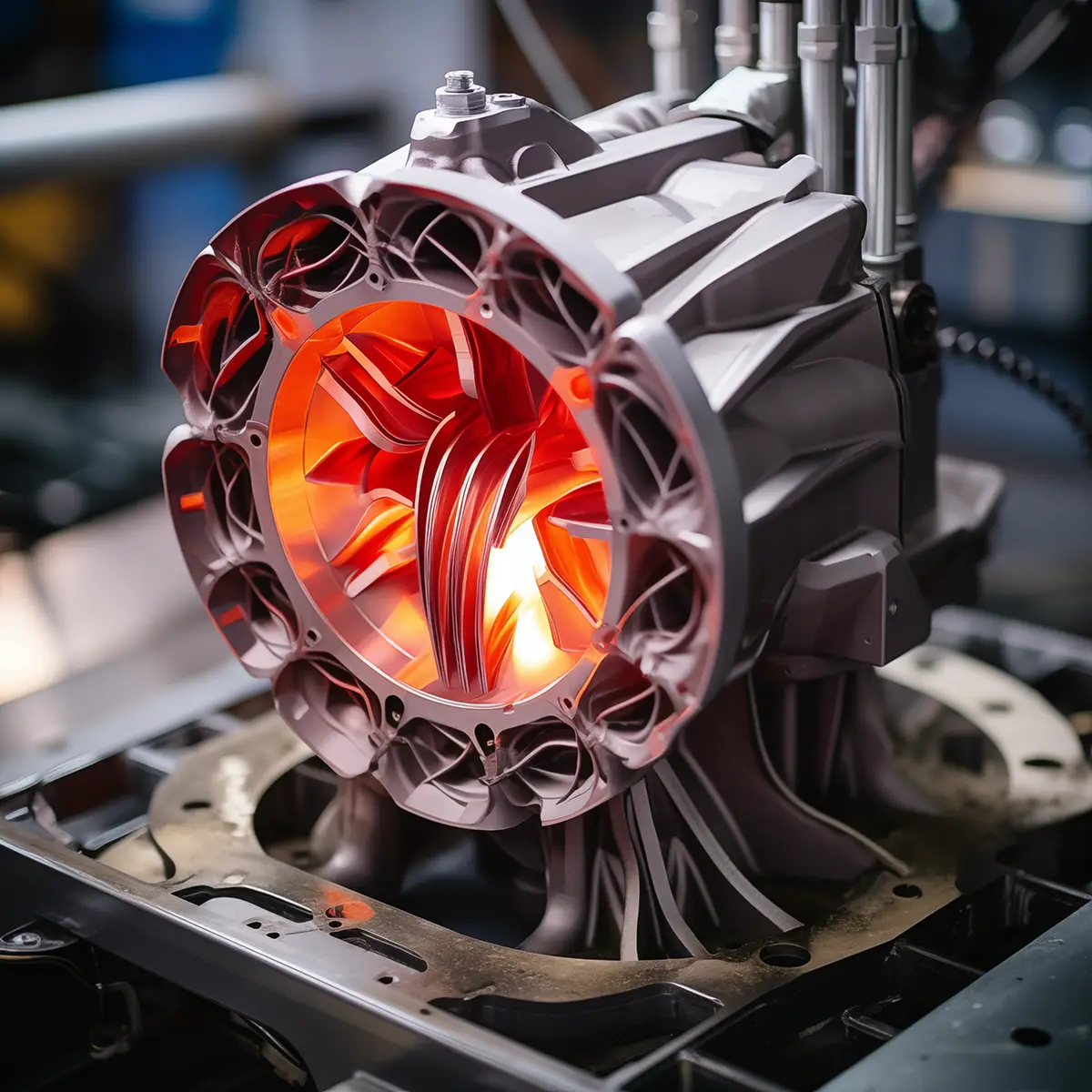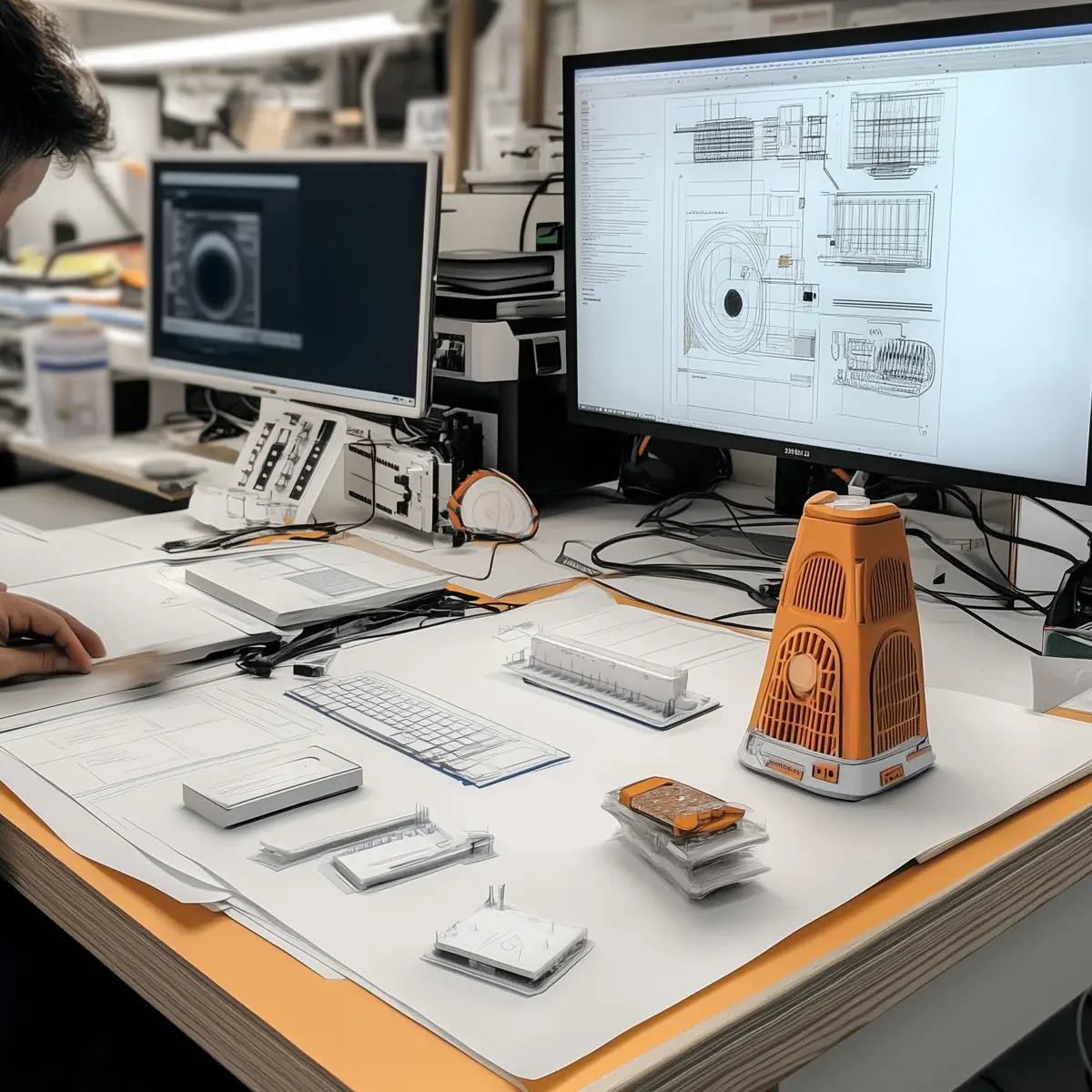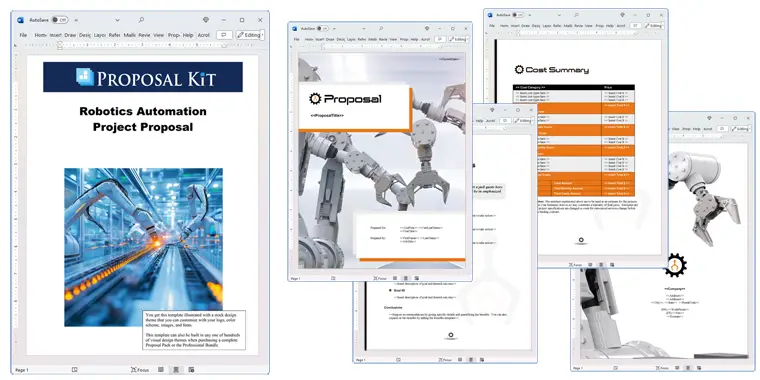How to write your Robotics Automation Project Proposal
We include this 36 page layout with every Proposal Pack. If you want this template to have a different visual design theme than the one illustrated here, purchase any Proposal Pack design and create this template using the purchased design theme. This template is included in every Proposal Pack. If you get a Proposal Pack or the Professional, you can also make any variation of this template with different chapters to suit your needs.
We typically include more chapters in the templates than most people will need to give everyone more variety in the chapters they may need. You can trim down a long template by removing pages you do not need or combining multiple chapter topics into one page.
 DOWNLOADABLE, ONE-TIME COST, NO SUBSCRIPTION FEES
DOWNLOADABLE, ONE-TIME COST, NO SUBSCRIPTION FEES![]() View Robotics Automation Project Sample Proposal
View Robotics Automation Project Sample Proposal
This sample proposal is based on the same layout as this template and is included in every Proposal Pack. The visual design of the templates will match whichever Proposal Pack design you purchase. To get this template in a different design theme than shown in the sample, purchase any other Proposal Pack design theme and this template will be included.
You can create an editable Word version of this sample in any design theme of your choice including branded to your logo.
You can also create countless variations of this document to suit your needs using the included library of 2200+ chapters if ordering a Proposal Pack or Professional.
 What Our Clients Say
What Our Clients SayI have used this software to write several proposals to get very good jobs in the event promotion business. the wizard walks you through every step and the tutorials are there to help answer any questions that you may have. I think it is an excellent program."
Related Article
Related Video
Related Templates
- Robot Design Project Proposal
- 3D Printing and Prototyping Services Proposal
- Prototyping, Fabrication and Machining Services Proposal
- Industrial Design Project Proposal
- Prototyping and Product Design Proposal
- Artificial Intelligence Project Funding Proposal
- Welding and Fabrication Services Proposal
- Machining Services Proposal
- Product Cost Savings Sales Proposal
- AI Powered Domestic Manufacturing Proposal Template
- Product Manufacturer Proposal
- Product Manufacturing Moving Overseas Proposal
- Drone Delivery of Supplies in Disaster Area Proposal
- New Product Idea Proposal
- Automation of Facilities and Production Proposal
- Vaccine Production and Distribution Proposal
- Collaborative Robotics Manufacturing Proposal Template
- Automation of Manufacturing Processes Proposal Template
- Shifting Production from Commercial to Consumer Proposal
- Advanced Manufacturing Proposal Template
- Retooling Production Line Proposal
- Electrical Engineering Project Proposal
- Intelligent Factory Reshoring RFP Template
- Software Automation Proposal
- Electrical System Upgrade Proposal
- Drone Mapping and Survey Services Proposal
- Software and Hardware System Proposal
- Industrial Automation Proposal
- Process Improvement Proposal
- Industrial Controls System Design and Implementation Proposal
- Advanced Robotics Integration Proposal Template
What's the best way to write your robotics automation project proposal?
Using the proven solution offered by Proposal Kit can make the process of writing a robotics proposal streamlined and efficient. This suite of templates and software stands out by incorporating a comprehensive line item quoting database system for creating detailed cost summaries, quotes, estimates, budgets, and other financial documentation, important for making your proposal persuasive and professional.
Do you need to write a proposal to automate an assembly line to boost production capacity and cut costs or design a robotics system for another project? If so, Proposal Kit is tailored for your needs, offering the tools to transform your vision into a winning proposal.
What Types of Projects Are Robotics Automation Project Proposals Written For?
Robotics automation project proposals cater to an array of situations designed to enhance efficiency, reduce operational costs, and integrate cutting-edge technology in manufacturing and production environments. These are examples of some of the situations for which proposals are created:
- Automating assembly line processes
- Implementing robotic welding systems
- Integrating AI-driven quality control
- Installing robotic packaging solutions
- Deploying automated guided vehicles (AGVs)
- Setting up robotic palletizing systems
- Introducing collaborative robots (cobots)
- Upgrading existing robotic systems
- Designing custom robotic solutions
- Implementing robotic material handling
- Developing automated inspection processes
- Establishing robotic painting systems
- Installing robotic machine tending
- Integrating smart sensors for data collection
- Implementing robotic sorting systems
- Building robotic pick-and-place systems
- Automating CNC machine operations
- Deploying robotic waste management systems
- Integrating robotics with IoT devices
- Establishing robotic food processing systems
Chapters this template is built with
A robotics automation project proposal requires customization to fit specific project needs, and Proposal Kit's extensive library enables the creation of custom tailored proposals. There is no one-size-fits-all premade template that works for every situation. Use Proposal Kit to build custom templates from its content library and template layouts such as this one. Below is a starting point of chapter templates available in the library that can be tailored to cover all necessary topics.
Cover Letter
The cover letter serves as the initial introduction, summarizing the proposal's purpose and highlighting your expertise in robotics automation. It sets the stage for the proposal by briefly mentioning the client's needs and how your solution will enhance their production capabilities through automation.
Executive Summary
This section provides an overview of the proposal, detailing the objectives and anticipated outcomes of the automation project. It concisely captures the essence of the proposal, highlighting the key benefits and expected improvements in production efficiency and cost reduction.
Cost Summary
Use this chapter to present a clear financial breakdown, demonstrating cost-effectiveness and potential savings from the robotic implementation. This section includes detailed financial projections, ROI estimates, and budget allocations to help stakeholders understand the financial impact.
Challenges
Identify and discuss the particular challenges faced in the current production process that the proposal aims to address. This chapter delves into inefficiencies, bottlenecks, and areas where automation can provide significant improvements.
Goals and Objectives
Clearly outline the proposed goals and objectives that the automation project intends to achieve. These may include targets such as increasing production speed, reducing waste, and minimizing manual intervention in critical processes.
Benefits
Highlight the anticipated benefits of adopting the proposed automation, such as increased efficiency and reduced error rates. This section outlines how the automation will lead to qualitative and quantitative gains for the client.
Project Deliverables
Detail the specific deliverables expected from the project, ensuring all stakeholders have a clear understanding of the outcomes. Include timelines, milestones, and final outputs that the robotics automation project will produce.
Automation
Discuss the automation technologies and processes that will be implemented to achieve the project's goals. Provide insights into how these technologies will transform the existing operations and integrate seamlessly into current workflows.
Production
Outline the impact of automation on current production methods and how it will enhance capacity and quality. This section discusses improvements in terms of speed, precision, and consistency in manufacturing outputs.
Testing
Describe the testing procedures that will be employed to ensure the reliability and effectiveness of the robotic systems. Include details on quality assurance, trial runs, and validation processes that will be conducted before full-scale implementation.
System Integration
Explain how the new robotic systems will integrate with existing processes and infrastructure. Discuss compatibility issues, necessary upgrades, and the steps to ensure a smooth transition without disrupting current operations.
Productivity Improvement
Provide evidence of how the automation will boost productivity and streamline operations. Use case studies, data models, and forecasts to illustrate the potential improvements in workflow efficiency.
Customization
Detail any customization needed to tailor the robotic systems to specific operational requirements. Discuss how the proposed solution can be adapted to meet the unique needs of the client's production environment.
Maintenance
Outline the maintenance plans necessary for ensuring the longevity and efficiency of the automation systems. This includes regular check-ups, software updates, and training for maintenance staff to keep the systems running optimally.
Risk Analysis
Conduct a risk analysis to identify potential challenges and mitigation strategies. Address issues such as technical failures, operational disruptions, and the contingency plans put in place to handle such situations.
Upgrades
Discuss future upgrades that might be required to maintain or enhance the system's performance. Highlight technological advancements that could benefit the client and how the current setup can be evolved over time.
Safety
Highlight safety measures and protocols to protect workers and equipment during and after the implementation. Discuss compliance with safety standards, employee training programs, and emergency procedures.
Hardware and Software
List the hardware and software components important for the robotic systems. Provide specifications and compatibility information to give stakeholders a clear understanding of the technical requirements.
Components
Detail the specific components of the robotic systems and their respective functions. Include descriptions of key parts, such as sensors, actuators, and control units, to illustrate how they contribute to the system's capabilities.
Adaptability
Discuss the system's adaptability to future changes in production requirements. Address how the proposed solution can be modified to accommodate shifts in production volumes or processes.
Robotics
Summarize the role of robotics in transforming the production process. Explain how robotics technology will provide a competitive edge and enhance overall operational efficiency.
Evaluation
Explain the evaluation process to measure the success and effectiveness of the automation project. Describe the metrics and benchmarks that will be used to assess the project's impact and guide continuous improvement.
Specifications
Provide detailed specifications of the robotic systems being proposed. Include technical details, performance metrics, and compliance with industry standards to ensure all requirements are met.
System Requirements
List the system requirements necessary for successful implementation. Cover topics such as power supply, network connectivity, and environmental conditions needed for optimal performance.
Performance Requirements
Highlight the performance benchmarks that the robotic systems must meet. Discuss criteria such as speed, accuracy, and uptime that the system is expected to achieve.
Monitoring
Describe the monitoring systems in place to ensure ongoing efficiency and effectiveness. Include details about data collection, analytics, and reporting tools used to track system performance.
Cost/Benefit Analysis
Present a thorough cost/benefit analysis to support the business case for the project. Compare the costs of implementation and maintenance against the financial and operational gains expected from the project.
Cost Savings
Detail the specific cost savings expected from implementing the automation project. Provide projections and examples of how reduced labor, material waste, and production time will translate into financial benefits.
Conclusions
Summarize the key points and reiterate the proposal's benefits and feasibility. Reinforce the value proposition and encourage stakeholders to consider the long-term advantages of automation.
Capacity
Outline the increased capacity expected from the automation implementation. Discuss how the new systems will allow for greater throughput and enable scaling operations to meet growing demand.
Reliability
Discuss the reliability standards that the robotic systems must adhere to. Highlight the importance of consistent performance and the measures taken to ensure system robustness.
Workforce
Address the impact of automation on the existing workforce and any necessary retraining. Discuss plans for upskilling employees and how automation will augment their current roles.
Schematics
Include any necessary schematics or diagrams to illustrate the proposed systems. Provide visual representations to help stakeholders understand the system layout and design.
Use cases for this template
Streamlining Production with Automation
The Challenge
TechRefine Solutions, a mid-sized manufacturer specializing in electronic components, was struggling with production inefficiencies. The company's reliance on manual processes resulted in frequent bottlenecks, delaying outputs and raising costs. Deadlines were often missed, causing dissatisfaction among clients and threatening future contracts. The management realized that modernizing their production floor was crucial to stay competitive and increase their market share.
The Solution
Recognizing the need for a comprehensive overhaul, the team at TechRefine turned to Proposal Kit to write a proposal for automating their assembly line. They used the software's robust collection of templates tailored specifically for automation projects. This allowed them to develop a detailed proposal outlining the integration of advanced robotic systems designed to streamline production. The templates provided guidance, ensuring all important elements - from technology specifications to financial projections - were addressed.
The Implementation
With Proposal Kit's detailed cost summaries and customization options at their disposal, TechRefine's proposal development process was seamless. They could easily incorporate critical financial data and align project goals within a coherent document. The software's intuitive interface allowed them to modify templates to suit their specific needs, providing a proposal that was both professional and persuasive. The ease of customization also meant that project-specific details were highlighted, which resonated well with decision-makers.
The Outcome
The proposal succeeded in securing the necessary approvals from stakeholders. TechRefine transitioned smoothly to a fully automated assembly line with minimal disruption to ongoing operations. The implementation of robotic systems led to a significant increase in production efficiency, reduced errors, and improved product quality. The successful automation strengthened TechRefine's competitive position in the industry and renewed confidence among its clients, paving the way for new business opportunities.
Accelerating Proposal Creation for Quick Wins
The Challenge
At Innovation Inc., a company known for its cutting-edge consumer electronics, the packaging department was facing critical inefficiencies. The existing process was outdated, labor-intensive, and prone to errors, leading to increased costs and delays. An internal audit revealed the urgent need for an automated solution. However, with a tight deadline for presenting a feasible automation plan, the team was under pressure to deliver a comprehensive proposal swiftly.
The Solution
Faced with this challenge, an employee at Innovation Inc. turned to Proposal Kit to expedite the proposal creation process. By using the software's expansive library of templates, they could quickly write a detailed plan for updating the packaging process with advanced robotics. To further optimize content generation, the employee employed AI writing tools. These tools analyzed Innovation Inc.'s website and internal data, generating content that was both relevant and precise.
The Implementation
The synergy between Proposal Kit's templates and AI-generated content facilitated a rapid proposal development. With the foundational topics in place, the employee focused on refining details and ensuring the proposal addressed the unique needs of their project. Proposal Kit's customization features made it easy to adapt the templates, allowing for a polished and professional document that communicated the project's objectives and benefits.
The Outcome
Innovation Inc. successfully met their internal deadline, presenting a proposal that not only impressed stakeholders but also set a new standard for efficiency within the organization. The proposal's approval led to the swift implementation of a state-of-the-art robotic packaging system. As a result, the company experienced a marked reduction in errors and costs, and the new system was operational well ahead of schedule, demonstrating the power of combining Proposal Kit with innovative AI tools for rapid proposal creation.
Creating a Compelling RFP for Environmental Impact
The Challenge
Robots for Good, a non-profit organization dedicated to environmental sustainability, was starting an ambitious project to incorporate robotics in waste management. The goal was to develop an efficient system that could sort and process waste autonomously, minimizing human intervention and maximizing recycling efforts. However, to realize this vision, they needed to write a Request for Proposal (RFP) that would attract capable vendors able to bring this project to life.
The Solution
The director of Robots for Good turned to Proposal Kit to create a detailed RFP that clearly communicated the project's requirements and expectations. With Proposal Kit's extensive template library, the director could easily customize sections to emphasize the project's potential impact on sustainability and align it with the organization's overarching mission. This clarity and detail were crucial for ensuring potential vendors understood the scope and significance of the project.
The Implementation
The Proposal Kit enabled the director to develop an RFP that was both comprehensive and compelling. By using the software's flexible templates, the proposal emphasized the innovative nature of the project and outlined detailed specifications, timelines, and evaluation criteria. This structured approach ensured that the RFP was attractive to vendors with the right expertise and vision, while also aligning with Robots for Good's goals.
The Outcome
The well-written RFP garnered numerous responses from qualified vendors, allowing Robots for Good to select a partner whose values and capabilities matched the organization's mission. The chosen vendor's expertise facilitated the successful launch of the project, which has since become a model for using robotics in waste management. The collaboration not only advanced the non-profit's goals but also positioned it as a leader in innovative environmental solutions, showcasing the power of a written RFP.
Conclusions and Recommendations
In creating a robotics automation project proposal, whether it is a bid for an external contract or an internal initiative, Proposal Kit is a robust tool to meet the challenges head-on. From writing a narrative to presenting precise financials, the software's customizable templates and line-item quoting system provide the framework for success. As seen in varied use cases, Proposal Kit ensures clarity, efficiency, and adaptability, empowering organizations to convert complex project needs into winning proposals.
Also Known As
This template may also be referred to in different ways or be used in more specialized situations, such as:
- Robotics Project Proposal
- Automation Proposal
- Assembly Line Automation Plan
- Robotics Integration Proposal
- Robotic Systems Proposal
- Automated Production Proposal
- Robotics Implementation Proposal
- Industrial Automation Proposal
- Robotics Efficiency Proposal
- Robotic Process Automation Proposal
Abstract
 Robotics automation project proposals are important documents that aim to transform production and operational topics through advanced automation solutions. These proposals strive to expand the capabilities of service robots and automated processes while enhancing the collaboration between human workers and machines. The proposed work often centers around addressing repetitive tasks and providing automation solutions where time-consuming and labor-intensive processes remain a challenge. The implementation process requires a comprehensive plan, with key milestones and a detailed timeline that guides the execution and deployment of next-generation technology.
Robotics automation project proposals are important documents that aim to transform production and operational topics through advanced automation solutions. These proposals strive to expand the capabilities of service robots and automated processes while enhancing the collaboration between human workers and machines. The proposed work often centers around addressing repetitive tasks and providing automation solutions where time-consuming and labor-intensive processes remain a challenge. The implementation process requires a comprehensive plan, with key milestones and a detailed timeline that guides the execution and deployment of next-generation technology.
Engineers and operators explore ways to integrate new systems with existing infrastructure, striving for seamless connectivity and interaction between automated solutions and current processes. By determining the economic benefits and evaluating the necessity of automation, these proposals communicate the potential for increased efficiency and cost savings. The project's path is defined through thorough research and the engagement of skilled personnel, ensuring that task responsibilities are clearly outlined.
Proposal Kit offers the ability to create compelling proposals using its extensive library of content and automated line-item quoting systems. This toolkit assists in breaking down complex ideas into manageable components, providing accurate financial projections and validating the feasibility of proposed solutions. By focusing on transparency, commitment, and the ability to solve operational concerns, these proposals address user feedback and constraints, ensuring a tailored solution that aligns with client needs.
 Automation proposals are designed to solve limitations and obstacles in existing systems, harnessing advanced algorithms and robotics technology. This approach allows for the expansion of capabilities, enhancing communication and interaction between machines and human operators. With a commitment to safety and reliability, these proposals outline the constraints and factors important for successful implementation. As clients and stakeholders evaluate the potential of robotic automation, the necessity for a well-structured and persuasive proposal becomes evident, paving the way for innovative and effective solutions in the industry.
Automation proposals are designed to solve limitations and obstacles in existing systems, harnessing advanced algorithms and robotics technology. This approach allows for the expansion of capabilities, enhancing communication and interaction between machines and human operators. With a commitment to safety and reliability, these proposals outline the constraints and factors important for successful implementation. As clients and stakeholders evaluate the potential of robotic automation, the necessity for a well-structured and persuasive proposal becomes evident, paving the way for innovative and effective solutions in the industry.
Robotics automation project proposals are reshaping the industrial landscape. They are created to address the project's aims, focusing on delivering a sophisticated RPA solution that meets modern production demands. In a world where efficiency and cost savings are critical, these proposals highlight how next-generation technology can revolutionize operations. By creating a project plan, stakeholders can navigate time-consuming challenges and optimize resources to achieve seamless integration and approval.
The use of Proposal Kit in developing these documents offers a robust framework that facilitates the assembly of complex proposals with precision and ease. Its content-rich templates provide engineers and project managers with a range of techniques to articulate their vision, ensuring that each step of the project plan is clearly defined and accessible to all involved parties. This knowledge-sharing approach helps teams to engage with their audience and determine the best path forward, enhancing the ability to predict outcomes and validate project goals.
 Beyond the technical topics, robotics automation projects hold significant promise for customers by introducing innovative concepts tailored to their unique needs. The inclusion of electrical systems and advanced steering mechanisms in these proposals demonstrates the commitment to delivering cutting-edge solutions. These projects are not just about replacing human labor; they are about augmenting it, providing operators with the tools to access insights and make informed decisions.
Beyond the technical topics, robotics automation projects hold significant promise for customers by introducing innovative concepts tailored to their unique needs. The inclusion of electrical systems and advanced steering mechanisms in these proposals demonstrates the commitment to delivering cutting-edge solutions. These projects are not just about replacing human labor; they are about augmenting it, providing operators with the tools to access insights and make informed decisions.
Moreover, these proposals consider the limited resources available to many organizations, offering scalable solutions that can be adapted to different environments. By using the support of the Proposal Kit, companies can ensure that every proposal is complete, capturing the essence of the project while addressing client constraints and expectations. This approach not only enhances the proposal's credibility but also increases the likelihood of project approval, demonstrating a clear understanding of the customer's needs and the industry's landscape.
Robotics automation project proposals are more than just technical documents. They are blueprints that guide organizations toward a future of enhanced productivity and innovation. By using Proposal Kit, businesses can streamline the proposal creation process, ensuring clarity and effectiveness in communicating their vision to stakeholders. As these proposals continue to evolve, they will play an important role in driving the adoption of automation solutions worldwide, transforming industries, and setting new standards for operational excellence.
 Robotics automation project proposals are transformative tools that not only outline the project aims but also envisage the integration of next-generation technologies into existing systems. These proposals address the challenges of time-consuming manual operations by pitching engaging solutions that streamline workflows and enhance productivity. In industries where efficiency and cost-effectiveness are critical, the introduction of automation offers significant competitive advantages, enabling businesses to remain agile and responsive to market demands.
Robotics automation project proposals are transformative tools that not only outline the project aims but also envisage the integration of next-generation technologies into existing systems. These proposals address the challenges of time-consuming manual operations by pitching engaging solutions that streamline workflows and enhance productivity. In industries where efficiency and cost-effectiveness are critical, the introduction of automation offers significant competitive advantages, enabling businesses to remain agile and responsive to market demands.
The development of such proposals requires a nuanced understanding of both current technological capabilities and future trends. The Proposal Kit serves as an indispensable resource in this respect, allowing teams to create documents that are comprehensive and tailored to specific project requirements. By employing this tool, organizations can note how automation aligns with their goals, communicating the benefits to stakeholders and facilitating informed decision-making.
Engaging with the target audience through these proposals involves not only detailing the technical topics but also emphasizing the human topic. Next-generation automation is designed to complement human efforts, allowing employees to focus on more complex and rewarding tasks. This approach fosters a more dynamic and innovative work environment, encouraging personnel to contribute their unique skills and insights towards the project's success.
 Ultimately, robotics automation project proposals are instrumental in guiding organizations through the complexities of technological transformation. They serve as blueprints for adopting cutting-edge solutions that address the inefficiencies of traditional processes. By using Proposal Kit, companies can efficiently navigate the proposal creation process, ensuring that all topics of the project are clearly articulated and aligned with broader organizational objectives. As industries continue to evolve, these proposals will remain crucial in driving the adoption of automation technologies, paving the way for a future characterized by increased productivity and innovation.
Ultimately, robotics automation project proposals are instrumental in guiding organizations through the complexities of technological transformation. They serve as blueprints for adopting cutting-edge solutions that address the inefficiencies of traditional processes. By using Proposal Kit, companies can efficiently navigate the proposal creation process, ensuring that all topics of the project are clearly articulated and aligned with broader organizational objectives. As industries continue to evolve, these proposals will remain crucial in driving the adoption of automation technologies, paving the way for a future characterized by increased productivity and innovation.
Frequently Asked Questions
How do I start writing a robotics automation project proposal?
Beginning a robotics automation project proposal involves outlining the project's scope and objectives. Start by identifying the specific processes that need automation and the expected benefits, such as increased efficiency or cost savings. Use Proposal Kit's templates to structure your proposal logically, starting with a cover letter and executive summary that captures the essence of your project. This initial groundwork sets the stage for a detailed exploration of the project's goals and the technology to be implemented.
What details should I include in the cost summary section?
In the cost summary section of your robotics automation project proposal, provide a detailed breakdown of all expenses associated with the project. This includes equipment costs, installation fees, maintenance expenses, and projected savings from increased efficiency. Proposal Kit's line-item quoting system can help you organize these figures clearly, ensuring stakeholders understand the financial implications and benefits of your proposal, which is crucial for gaining approval.
How can I communicate the benefits of automation in my proposal?
To communicate the benefits of automation in your proposal, focus on how the project will improve production processes and reduce operational costs. Use specific examples and data to illustrate potential improvements in efficiency, quality, and speed. Highlighting these benefits in the Benefits section of your robotics automation project proposal will help stakeholders grasp the potential return on investment, making a stronger case for the project.
How do I address potential risks in my proposal?
Addressing potential risks in your robotics automation project proposal involves conducting a thorough risk analysis. Identify possible challenges, such as implementation hurdles or technology failures, and devise strategies to mitigate these risks. Include this analysis in a dedicated Risk Analysis section, outlining contingency plans and safety measures. This proactive approach demonstrates preparedness and reassurance to stakeholders regarding the feasibility and reliability of the proposed automation.
What should I focus on when writing the executive summary?
When writing the executive summary of your robotics automation project proposal, concentrate on presenting a concise overview of the project's goals, scope, and expected outcomes. Summarize key topics such as the benefits of automation, cost implications, and implementation timeline. The executive summary should capture the attention of decision-makers, providing them with a clear snapshot of the proposal's value proposition and encouraging them to look further into the details.
20% Off Discount
![]() Add To Cart This Word Template
Add To Cart This Word Template
 Add To Cart Proposal Pack Robotics #2
Add To Cart Proposal Pack Robotics #2
 Add To Cart Proposal Kit Professional
Add To Cart Proposal Kit Professional
 4.7 stars, based on 849 reviews
4.7 stars, based on 849 reviewsProposal Kit chapters used in this template
Cover Letter, Title Page, Table of Contents, Executive Summary, Robotics, Goals and Objectives, Benefits, Challenges, Productivity Improvement, Workforce, Hardware and Software, Components, System Integration, Automation, Capacity, Monitoring, Customization, Adaptability, Production, Maintenance, Upgrades, Risk Analysis, Safety, Testing, Reliability, Evaluation, Project Deliverables, System Requirements, Performance Requirements, Specifications, Schematics, Cost Summary, Cost/Benefit Analysis, Cost Savings, Conclusions, Back Page
Line Item Automated Chapters
If you purchase a Proposal Pack or the Professional Bundle, these proposal pages are generated using an automated line-item database in the included Wizard software.
Cost Summary, Cost Benefit Analysis
You use this proposal for
- General business proposal
- Technical proposal
- Project pitch proposal
- RFP response
- IT, software, hardware proposal
How to create this template with Proposal Pack Wizard
You can create this document using any of the logo-designed Proposal Packs. Pick any Proposal Pack with a logo design theme you like best; they will all work equally well. The Proposal Pack for Any Business is the pack with no extra added logos or colors - designed to be used plain or for you to customize with your logos and graphics.
The Proposal Pack design theme you purchase will determine the visual look of this template. The screenshot above only shows the plain generic design theme.
We include a library of chapters to be assembled based on your needs. All proposals are different and have different needs and goals. We designed Proposal Pack so you can customize the documents to suit your needs.
You will best create this document using the Proposal Pack Wizard - Expert Edition software to select this template and build it in the Proposal Pack logo design theme of your choice along with any desired customizations (such as adding additional chapters, removing unneeded chapters, changing the order of chapters, and importing your company logo). This template outlines a proposal for the described situation. Each user is responsible for typing in the actual content of the provided pages with their information to complete the proposal. Suggestions in the abstract may include features in higher-end packages and are facilitated by the selection of chapter templates to support the narrative of each proposal, which help guide the user in filling in the details.
The Wizard software's AI Writer will write the content of the pages of the template based on details provided for your company, client, project, financial details and other writing instructions. This will provide a personalized version of the template completely written and ready to edit.
Once finished, the AI Writer's Word-to-PowerPoint converter can transform your proposal, business plan, or other business documents into a PowerPoint slideshow. Save time and effort by letting the AI analyze every chapter to condense its content into talking points, visually matching the document, and providing a consistent package of presentation material with the click of a button.
You create this template using the Wizard software with an entire Proposal Pack library and software. We include the Expert Edition of the software in the Proposal Kit Professional. Microsoft Word for Windows is required to use the customizing software. You can also edit Word document templates in other office software such as Word for Mac. We will assist Mac users in assembling complex templates for their first project if they do not have the required platform to run the Wizard software.
How to Build Templates Featured on Proposal Kit Website
Many people find the Proposal Kit website after searching for a specific proposal. Once you've purchased and installed the software, how do you build that template you found in the first place? This video shows you how to build any proposal you see on the Proposal Kit website.
 Ian Lauder has been helping businesses write their proposals and contracts for two decades. Ian is the owner and founder of Proposal Kit, one of the original sources of business proposal and contract software products started in 1997.
Ian Lauder has been helping businesses write their proposals and contracts for two decades. Ian is the owner and founder of Proposal Kit, one of the original sources of business proposal and contract software products started in 1997.By Ian Lauder
 Published by Proposal Kit, Inc.
Published by Proposal Kit, Inc.


 Cart
Cart
 Get 20% off ordering today:
Get 20% off ordering today: 


 Facebook
Facebook YouTube
YouTube Bluesky
Bluesky Search Site
Search Site